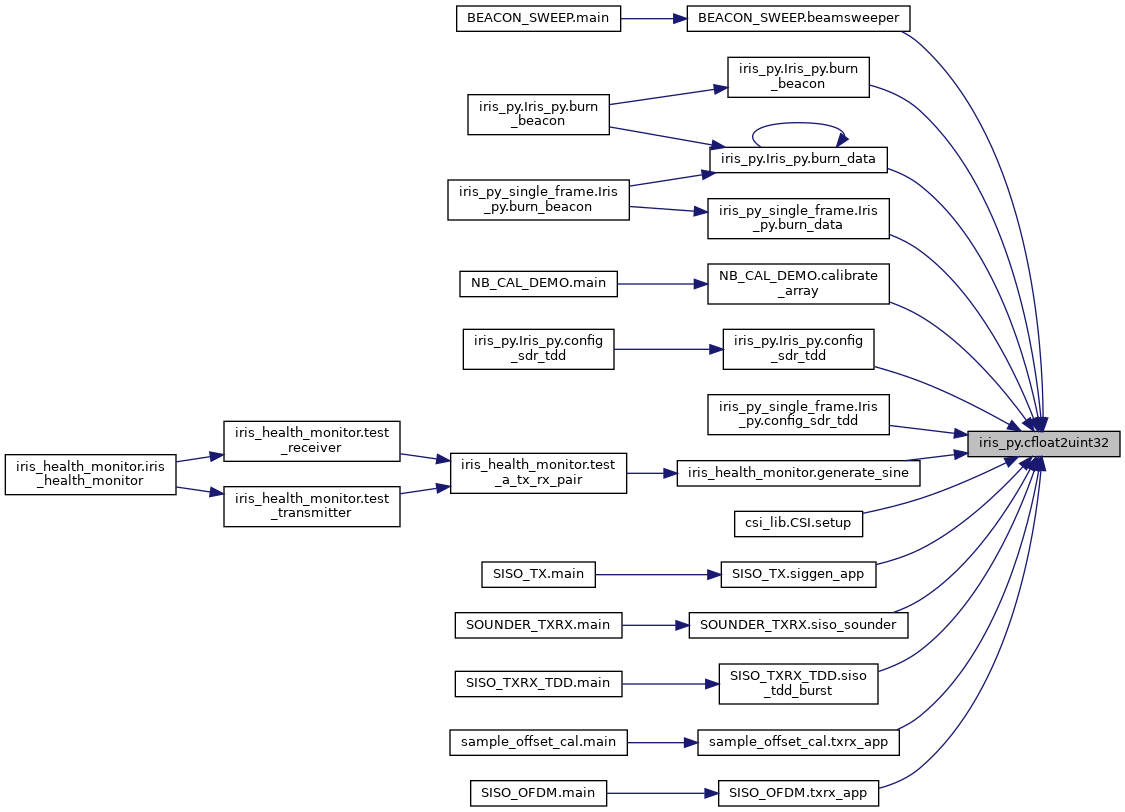Classes | |
| class | Iris_py |
| SDR Class: #######. More... | |
Functions | |
| def | gen_lts (seq_length=128, cp=0, upsample=1) |
| def | cfloat2uint32 (arr, order='IQ') |
Function Documentation
◆ cfloat2uint32()
| def iris_py.cfloat2uint32 | ( | arr, | |
order = 'IQ' |
|||
| ) |
Convert floating point iq values to uint32 (FPGA format) ARGS: - arr: Data array - order: Whether it is IQ or QI RETURNS: - corresponding uint32 value
Here is the caller graph for this function:

◆ gen_lts()
| def iris_py.gen_lts | ( | seq_length = 128, |
|
cp = 0, |
|||
upsample = 1 |
|||
| ) |
Here is the caller graph for this function:

Variable Documentation
◆ ampl
| int iris_py.ampl = 1 |
◆ args
| iris_py.args = parser.parse_args() |
◆ ax1
| iris_py.ax1 = fig.add_subplot(2, 1, 1) |
◆ ax2
| iris_py.ax2 = fig.add_subplot(2, 1, 2) |
◆ bcn_imag
| iris_py.bcn_imag |
◆ bcn_real
| iris_py.bcn_real |
◆ beacon
◆ beacon1
| iris_py.beacon1 = siso_bs.config_beacon(nsamps_pad) |
◆ beacon1_i
| iris_py.beacon1_i = np.imag(beacon1) |
◆ beacon1_r
◆ CORR_CONF
| int iris_py.CORR_CONF = 60 |
◆ CORR_RST
| int iris_py.CORR_RST = 64 |
◆ CORR_THRESHOLD
| int iris_py.CORR_THRESHOLD = 92 |
◆ corr_threshold
| int iris_py.corr_threshold = 1 |
◆ cp
| iris_py.cp |
◆ default
| iris_py.default |
◆ dest
| iris_py.dest |
◆ fig
| iris_py.fig = plt.figure(figsize=(20, 8), dpi=100) |
◆ float
| iris_py.float |
◆ foundTrigger
| iris_py.foundTrigger = siso_ue.sdr_gettriggers() |
◆ FPGA_IRIS030_WR_PKT_DET_ENABLE
| int iris_py.FPGA_IRIS030_WR_PKT_DET_ENABLE = 296 |
◆ FPGA_IRIS030_WR_PKT_DET_NEW_FRAME
| int iris_py.FPGA_IRIS030_WR_PKT_DET_NEW_FRAME = 300 |
◆ FPGA_IRIS030_WR_PKT_DET_NUM_SAMPS
| int iris_py.FPGA_IRIS030_WR_PKT_DET_NUM_SAMPS = 292 |
◆ FPGA_IRIS030_WR_PKT_DET_THRESH
| int iris_py.FPGA_IRIS030_WR_PKT_DET_THRESH = 288 |
◆ freq
| float iris_py.freq = args.freq |
◆ help
| iris_py.help |
◆ hub
| iris_py.hub = None |
◆ is_bs
| iris_py.is_bs |
◆ label
| iris_py.label |
◆ lts_f
| iris_py.lts_f |
◆ ltsSym
| iris_py.ltsSym |
◆ n_sym_samp
| int iris_py.n_sym_samp = nsamps + 2*nsamps_pad - 14 |
◆ nsamps
| iris_py.nsamps = siso_bs.n_samp |
◆ nsamps_pad
| int iris_py.nsamps_pad = 82 |
◆ pad1
| iris_py.pad1 = np.zeros((nsamps_pad), np.complex64) |
◆ pad2
| iris_py.pad2 = np.zeros((nsamps_pad-14), np.complex64) |
◆ parser
| iris_py.parser = ArgumentParser() |
◆ prefix_len
| iris_py.prefix_len |
◆ RF_RST_REG
| int iris_py.RF_RST_REG = 48 |
◆ SCH_ADDR_REG
| int iris_py.SCH_ADDR_REG = 136 |
◆ SCH_MODE_REG
| int iris_py.SCH_MODE_REG = 140 |
◆ siso_bs
| iris_py.siso_bs |
◆ siso_ue
| iris_py.siso_ue |
◆ str
| iris_py.str |
◆ TDD_CONF_REG
| int iris_py.TDD_CONF_REG = 120 |
◆ tdd_sched
| iris_py.tdd_sched |
◆ tx_advance
| int iris_py.tx_advance = 68 |
◆ TX_GAIN_CTRL
| int iris_py.TX_GAIN_CTRL = 88 |
◆ type
| iris_py.type |
◆ unpack
| iris_py.unpack |
◆ upsample
| int iris_py.upsample = 1 |
◆ wave_rx_a_bs_mn
| iris_py.wave_rx_a_bs_mn = siso_bs.recv_stream_tdd() |
◆ wb_pilot
◆ wb_pilot1
◆ wb_pilot1_i
| iris_py.wb_pilot1_i = np.imag(wb_pilot1) |
◆ wb_pilot1_r
◆ wb_pilot2
| iris_py.wb_pilot2 = wbz |
◆ wbz
| iris_py.wbz = np.zeros((n_sym_samp), dtype=np.complex64) |
